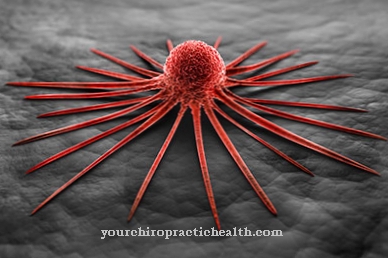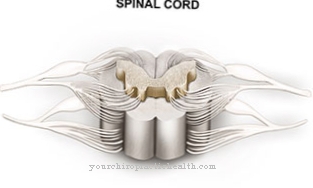Hives (urticaria), also Nettle rash, is a complicated and complex skin disease. It occurs as a result of an oversensitivity reaction to various chemical and natural substances or external stimuli on the skin. Around 10 to 20 percent of people in Germany have had hives at one point in their life. Hives are not contagious, but should be examined and treated by the doctor as soon as possible, as in some cases it can lead to circulatory shock and then a life-threatening situation.
What is hives (urticaria)?
.jpg)
The Hives is called in medical terminology Urticaria denotes and is characterized by characteristic red wheals on the skin, which arise from smaller, reddened bumps. In principle, these can occur on any part of the body, some are more prone to it than others.
Acute hives is a form that lasts for 6 weeks in the longest case and then regresses. If the symptoms last longer, it is called chronic hives.
causes
Usually the Hives triggered by histamines released by the skin's mast cells. As a result, the small bumps are initially formed, which gradually expand into wheals. The causes for the release of histamines are different. It can be an autoimmune reaction, for example. The body does not tolerate the substances it releases itself.
In response, hives develop. However, there may also be hypersensitivity to a substance that either comes into direct contact with the skin or passes through the digestive tract. This can be coloring or flavoring, but also pathogens such as bacteria that express themselves exclusively through this symptom. In rarer cases, there is a real allergy that manifests itself as hives.
The other two major causes of hives include the physical and the psychological state. External stimuli such as pressure or scratching can cause red wheals to appear on the affected area, which regress over time or only after a long healing process. Stress or psychological distress can also be the trigger for hives.
Symptoms, ailments & signs
Hives are the first to appear through itching and the typical wheals. As a result of the water retention, the surface of the skin swells and inflammatory areas develop that are sharply defined and painful on contact. These wheals can be white to reddish and a few millimeters to two centimeters in size.
Several wheals can combine to form a large skin lesion. This can lead to bleeding and, in individual cases, to ulcers. Typical accompanying symptoms are also feelings of tension and skin irritations, for example sensory disorders or overheating. Occasionally the wheals appear accompanied by so-called angioedema.
This is pad-like swollen subcutaneous tissue that is normally painless. However, redness, itching and a feeling of tension can occur. Angioedema occurs mainly on the face, palms, and soles of the feet. In individual cases, the mucous membranes are also affected.
Wheals resolve within a day. In chronic hives, the skin changes can persist for weeks, months, or even years and affect large areas of the skin. If hives occur as part of an allergy, anaphylactic shock can occur, which is associated with shortness of breath, sweating, palpitations and, finally, circulatory shock.
Course of disease
The course of the Hives depends on the form of the disease. The acute form of the disease usually only lasts for a few days or a few weeks. The maximum duration of acute hives is six weeks. As already mentioned, typical symptoms are a very itchy rash with reddish wheals and, in rare cases, painful swellings of the skin.
The chronic hives however, it can last up to several years or occur again and again. However, the symptoms of acute hives are less common. Chronic hives should always be treated by a doctor in order to research the cause and thus find out potential allergies or hypersensitivity to certain foods that are responsible for the chronic hives.
Complications
In most cases, people with hives suffer from various skin conditions. These are very uncomfortable and can mean a significantly reduced quality of life for the person concerned. In most cases, a rash develops on the skin. This rash is also itchy, so scratching can also cause scars.
Children in particular scratch themselves constantly, which can lead to bleeding. The skin itself is white in color in the affected areas and in some cases is also slightly swollen. The hives can also spread to the tongue or the mucous membranes. This can also lead to shock and, in the worst case, heart failure.
However, this case only occurs very rarely. As a rule, the hives can be reduced relatively easily with the help of medication. The patient may be dependent on light therapy. However, there are no particular complications. The hives usually do not have a negative impact on the life expectancy of the patient.
When should you go to the doctor?
If the skin symptoms remain unchanged for days, this should be clarified by a doctor. If skin changes increase, it is advisable to see a doctor in the next few days.
In the case of itching, medication to relieve itching may be necessary. Which medications are suitable or which alternative to drug therapy is available can be clarified with the family doctor. If there is breathlessness, circulatory problems or swelling of the body, emergency action is required, as a life-threatening condition can arise. If there is swelling, e.g. on the face, a specialist in emergency medicine can quickly relieve symptoms with medication. In the case of chronic disease, urticaria advice can be obtained in special treatment centers. The focus here is on helping people to help themselves. Frequent visits to the doctor, which can reduce the quality of life, are avoided.
If you are unsure whether a doctor's visit is necessary, it is advisable to do this as a precaution. Also accompanying psychological complaints, which e.g. are a consequence of the itching can be discussed with the family doctor. A further referral to specialists who specialize in psychological support or skin diseases is made via the family doctor.
Treatment & Therapy
The acute Hives is usually not treated. In most cases, the wheals resolve on their own. Depending on the cause, this can happen within a few minutes, but it can also take a few weeks.
In chronic hives, antihistamines and cortisol are used. However, both drugs only suppress the symptom of an underlying disease. That is why it must be determined at the same time, the reason for which chronic hives developed.It can only be eliminated in the long term if the trigger is also eliminated. If there is an underlying bacterial infection of the digestive tract, the hives will only go away permanently if the bacteria are combated and killed. Accordingly, individual therapy with specific drugs for the respective disease is required.
Medicines do not help with psychological causes. In such cases, it is important to find the trigger and eliminate it in the long term. The psychologist can provide support.
You can find your medication here
➔ Medicines for rash & eczemaOutlook & forecast
There are very good treatments for hives these days. The most important thing here is to find out what caused the disease. This can be done by keeping a diary. If the drug treatment works well, a symptom-free condition can be achieved for the patient. The unpleasant hives are prevented by avoiding the trigger and by taking long-term medication. The prognosis for hives is therefore very good if the treatment is successful.
If left untreated, hives lead to spontaneous swelling of the skin, reddening, itching and burning. The symptoms are very uncomfortable for those affected. They can last up to 24 hours and severely limit the patient's everyday life and quality of life. Sleep disorders, a decline in concentration and performance (at school or work) are not uncommon. As a result, sex life can suffer and depression, withdrawal and anxiety can have a massive impact on those suffering from hives.
The prospect of a cure or learning to live with the disease is very good in times of modern medicine. There is not only sufficient specialist literature for an extensive research into the causes, but also enough medicinal and homeopathic approaches that enable a symptom-free life with hives.
prevention
One can prevent that Hives only if the cause is known. If it is physically conditioned, it is important to avoid situations in which it could arise again.
In the case of allergic reactions, the body must be kept away from the substance to which it is reacting. The same applies to hives that occur as a result of an intolerance.
Prevention becomes more difficult if it is a psychosomatic hives. Since stress, in particular, can hardly be effectively avoided in everyday life, the patient must be taught how to deal with stressful situations effectively and thus prevent the development of physical symptoms.
Aftercare
Once those affected have gone through the acute treatment phase, it must be determined which trigger caused the hives. This can be indicated by chemical or biological factors such as infections, food, medication or insect venom, or it can be the result of physical irritation from friction, cold, pressure, heat or light.
If the trigger can be suspected with a high probability in the food, an elimination diet should be followed. This is important in order to avoid serious complications such as glottal or Quincke's edema in the future. With this special form of nutrition, the sick person receives only tea, water, potatoes and rice for a week.
These foods are generally considered to be minimally irritating, which means they do not contain any flavoring, fragrance, coloring or preservatives, which could lead to urticaria. When the immune system has been cured after a week of dieting, the provocation test series begins in the follow-up. Little by little, the patient receives a food that can be responsible for the hives.
The cause can be identified through strict documentation of the skin and mucous membrane reaction. The provocation test also includes a skin test in which a small area is exposed to various physical stimuli. Here too, the reactions are precisely documented. If those affected then know about the causes of urticaria, they can avoid this uncomfortable condition in the future.
You can do that yourself
In everyday life, people affected by hives should ideally know exactly what they are allergic to. This makes it possible to avoid certain ingredients as much as possible. It is not always easy to find out what is causing hives. It can therefore be helpful to keep a log: When do the wheals occur and in what context? Sometimes a close-knit protocol can be used to identify a trigger for the itching and wheals.
Especially when the potential triggers of hives are unclear, it is important that those affected have the necessary medication in their medicine cabinet. The hives can be so severe that the eye swells completely. In the worst case, the airways can also be obstructed in the case of severe uriicaria. Self-help in acute cases is not possible here.
While minor symptoms of hives can often be alleviated in everyday life with appropriate antihistamines, shortness of breath is always a medical emergency. Relatives should be familiar with the external symptoms and know that they must call an emergency doctor immediately if they are short of breath. This can quickly stop the allergic reaction with special drugs that are administered intravenously.


.jpg)
.jpg)








.jpg)



.jpg)










.jpg)
